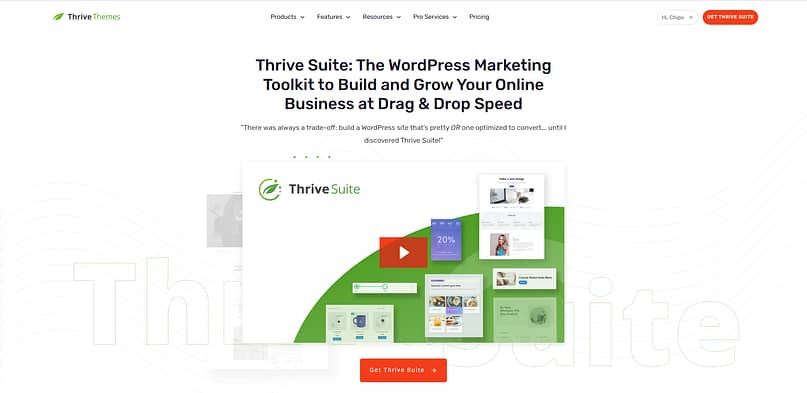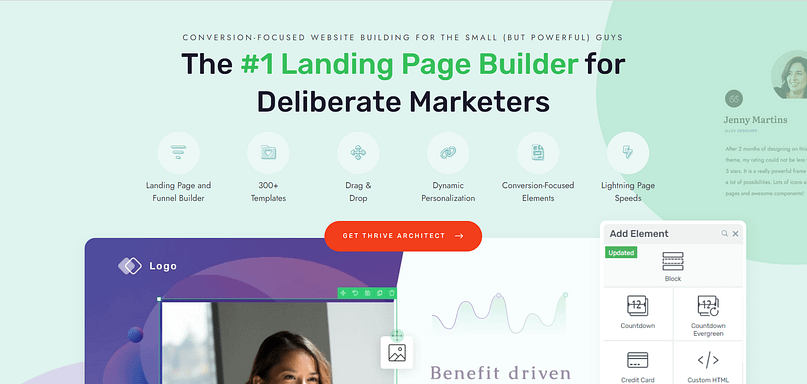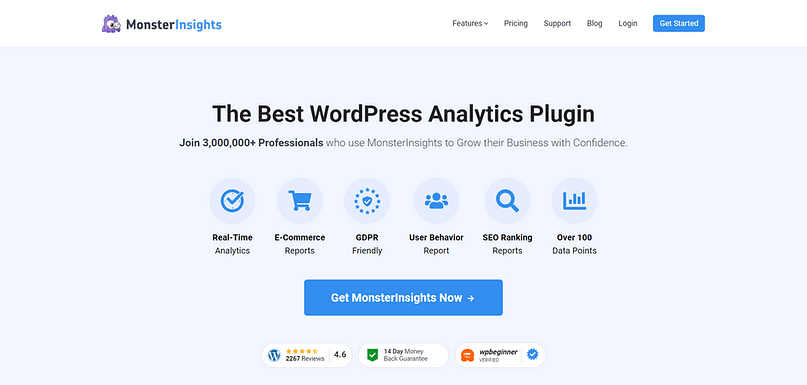You’ve got a course. Maybe it’s live. Maybe it’s still chilling in your Google Drive under “final_final_actuallydone.mp4.” Either way, the question hits:
How do you market it without draining your bank account?
You search budget friendly course marketing and get hit with advice like “post on five platforms daily” or “just start a podcast.” Great. Right after I invent a clone and give up sleep.
Here’s the truth:
More effort isn’t the answer. Better strategy is.
Fun (and slightly painful) fact: According to Thinkific, over 60% of full-time creators earn less than $10K per year — a reminder that simply having a course isn’t enough to guarantee sales.
That stat hit me hard when I first saw it because I’ve been there. I poured weeks into perfecting every module, only to launch to… well, polite silence.
This post is here to change that.
If you’re overwhelmed, underfunded, unsure of how to market an online course, but want to find ways to make your course business a reality…you’re in the right place.
Let’s talk real tactics for course marketing on a budget. Just real ways to promote your online course free or close to it, starting today.
What You’re Up Against (And Why It’s Not Your Fault)
Let’s cut the guilt and get honest for a second.
You’ve created a course (or you're knee-deep in building one). You’ve battled tech gremlins, re-recorded your voice 80 times because “it sounded weird,” and maybe even cried over a slide deck (no judgment, I’ve been there).
You followed the advice. The YouTube tutorials. The tweet threads. You posted on Instagram. Made a Canva graphic. Spent hours writing a “value-packed” email sequence.
And… crickets.
Here’s a stat that stings a little:
75% of online course creators earn less than $1,000 per year. And this one? Only 1% make it past $50,000. (Source: MemberPress)
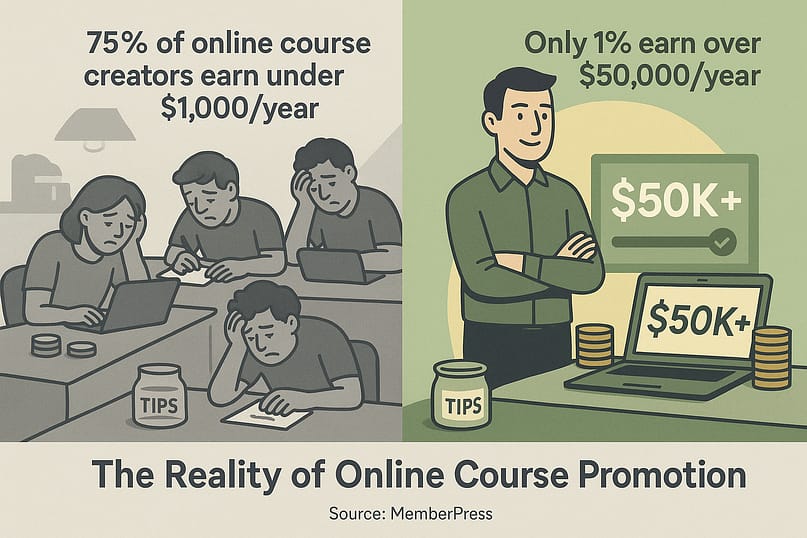
But here’s the part no one tells you:
It’s not your content that’s the problem. It’s not that you’re “not cut out for this.”
It’s that no one gave you a real plan for how to market an online course — just a sea of scattered tactics that don’t connect.
You’ve been handed the wrong tools, incomplete strategies, and a pile of conflicting advice that assumes you’ve got money, time, and a team.
Spoiler: most of us don’t.
And meanwhile, you’re told to:
“Run Facebook ads”
“Start a podcast”
“Hire a funnel strategist”
“Invest in a $3,000 mastermind”
Or build a flashy digital product funnel that no one explains how to actually set up

It’s overwhelming. It’s frustrating. And it’s not your fault.
Because a huge budget won’t save a scattered strategy — but a smart, focused system built for course marketing on a budget? That will.
That’s what this post is about. Budget friendly course marketing that’s scrappy, strategic, and built for creators like you — the ones doing it solo, figuring it out as they go, and still daring to believe in their offer.
So before you spiral into thinking you're not cut out for this, take a breath. You’re not behind. You’ve just been following the wrong roadmap.
This post? It’s your reset button.
Next up: let’s talk about the tools that’ll make all of this a whole lot easier (and actually fun to use).
Why the Right Tools Make Budget Marketing Easier (Not Harder)
Here’s the thing no one tells you about budget friendly course marketing:
Doing it all manually? That’s not saving you money — it’s costing you time, energy, and probably a few brain cells. (Been there. Burned out there.)
I used to spend hours trying to duct-tape together a “system” that relied on three plugins, two workarounds, and a prayer. One for the form, one for the course, one for the design — none of them talked to each other. And when something broke? I did too.

So here’s what I tell every course creator now — especially if you’re trying to sell online courses on WordPress without mortgaging your future:
You don’t need more tools. You need tools that actually work together.
Enter Thrive Suite — the stack I wish I’d started with instead of whatever Frankenstack I tortured myself with back then.
It’s not a “do-it-all” promise wrapped in fluff. It’s a set of tools made for creators who want control without coding, and conversions without chaos:
Thrive Architect – Build landing pages and site content that look like you paid someone fancy, even if you're still in your pajama pants.
Thrive Apprentice – Deliver your free and paid courses in a way that looks legit and feels seamless.
Thrive Leads – Power your email marketing for online courses with forms that actually convert (no 2007 design needed)
Thrive Quiz Builder – Add a layer of low-cost lead generation with quizzes that double as student assessments and segment your audience automatically
Thrive Optimize – A/B test your headlines, CTAs, and entire landing pages with zero third-party fluff.
Here’s why this matters:
25% of creators earn the majority of their income from their own website or blog — even though only 2% have their biggest audience there. (Linktree Creator Report)
Translation? The creators making it work are doing so on their own turf. They’re not betting everything on the algorithm. They’re building digital product funnels on platforms they control — and they’re using tools that help them convert, not just exist.
And because Thrive is made for WordPress, it’s actually built for course marketing on a budget.
You’re not paying for five disconnected tools. You’re not getting hit with monthly fees, per-course pricing, or “sorry, that feature’s only in Pro.”
You own it. You control it. You scale when you're ready.
Alright, tools? Handled.
Let’s talk strategy. Because marketing your course on a budget shouldn’t feel like a guessing game — it should feel like a plan that actually works.
7 Budget Friendly Course Marketing Strategies That Actually Work
Now that we’ve got your tools sorted (and your tech stress levels down), let’s get into what you really came here for:
How do you actually promote an online course free — or close to it — and still make sales?
These aren’t vague ideas like “just be consistent” or “create value.” These are practical, spicy, try-this-today strategies designed to work for real creators with real lives — and very real budgets.
If you’ve been stuck refreshing your sales dashboard wondering why no one’s buying, don’t worry. We’re about to flip the script.
Each of these tactics is built for:
Solo creators (with no VA in sight)
WordPress users who don’t want to overpay for all-in-one platforms
People who care about low-cost lead generation and actual conversions — not just traffic for traffic’s sake
And anyone trying to master course marketing on a budget without feeling like they’re shouting into the void
Let’s get into it.
1. Turn Your WordPress Site Into a Conversion-First Hub
If you're building your course on a budget, your website has to pull its weight — and no, I don’t mean just looking nice. This is your main online course promotion tool.
It needs to do something. Capture leads. Guide people to your course. Help visitors go from “curious” to “enrolled” without you lifting a finger.
For a long time, my website didn’t. And some of my early clients’ websites, too. True story. I was proud of it (sort of), but it didn’t have a clear next step. It just sat there. And let me tell you — watching crickets hit your site and leave? That’ll humble you real quick.
Eventually, I realized I needed something simple, flexible, and not outrageously priced — which is when I found Thrive Architect. Take it from me, this is the tool you need for WordPress course marketing.
At the time, I had no design skills. I just wanted to create a homepage and course page that didn’t look like I built them at 2 a.m. with broken Wi-Fi. Thrive Architect let me drag, drop, and actually design for conversions — not just vibes.
And because it’s built for WordPress (no weird extra platforms), it’s a genuinely budget friendly course marketing move.
You’re not patching together five clunky tools that barely talk to each other. You’re using a page builder that’s designed to work seamlessly with your course builder — no hacks, no headaches.
And with Thrive Suite? You get all of it — landing pages, courses, lead gen, A/B testing, quizzes — for around the same price most people pay for just an LMS plugin.
Honestly? It’s kind of a no-brainer.
Here’s what I changed that actually worked:
I made the headline focus on the result — not the course title.
I moved testimonials above the call-to-action.
I replaced “Buy Now” with “Start Learning Today.”
If you’re using WordPress, this is one of the easiest, lowest-cost upgrades you can make. Your site doesn’t need to be fancy — it just needs to be focused.
2. Create Content That Markets for You (While You Sleep)
I used to think blogging was just something influencers did between brand deals and oat milk lattes. Turns out? It’s one of the most powerful budget friendly course marketing moves you can make — especially when you do it with strategy, not just vibes.
Content marketing for courses actually works – and the numbers back it up too.
💡 Businesses that blog can generate get up to 55% more site visitors than those that don’t.
And this isn’t just theory.Let’s look at what worked for real course creators.
Take Create and Go — they built a wildly profitable course business by publishing beginner-friendly blog posts that answered their ideal students' exact questions.
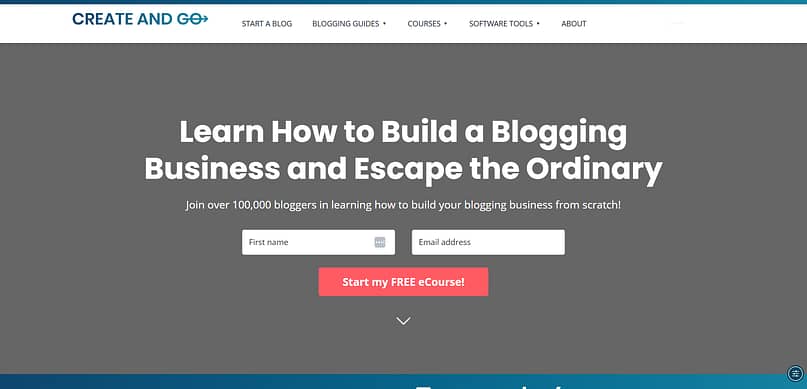
Then they linked it to a simple 5-day bootcamp lead magnet and used email marketing for online courses to do the rest — no ads, no fluff, just content that converted.
That’s the magic: blog once, and let the traffic, trust, and enrollments compound over time.
When someone Googles a problem your course solves, and your post is there offering real help? That’s warm traffic. That’s “I’m halfway convinced already” energy.
And the best part? You don’t need to be a pro writer or publish three times a week to make this work.
Here’s what I did instead (and what I recommend for beginners):
Pick 3–5 core problems your course solves.
Write one blog post for each — nothing fancy, just actually useful.
Inside each post, link to a freebie or free preview lesson (hosted in Thrive Apprentice) to capture the lead.
For example, if your course was about Marketing with AI, you could write a post like: “Why You’re Struggling With Marketing on Your Own — and How to Fix It Without Burning Out” It’s simple. It’s real. And it will get shared way more than a generic post that doesn’t connect.
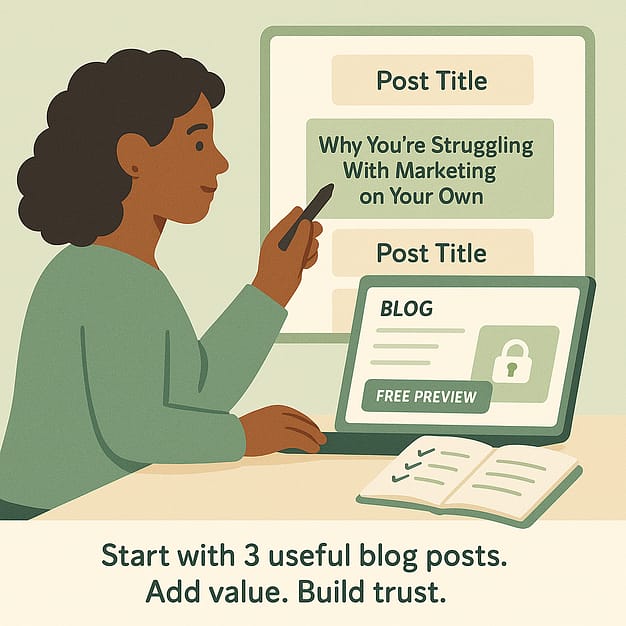
Bonus move: Embed a short 1–2 minute video at the top of your post using Thrive Architect — even if it’s just you talking to camera. It builds trust fast and boosts time on page, which Google loves.
This is one of the best free course marketing tips out there — and it scales with you. You’re not on a content hamster wheel — you’re building a long-term SEO engine that compounds over time.
What if you’re “not a writer”?
You’re not alone — but that’s no reason to stay stuck.
These days, AI makes an amazing creative buddy. With the right prompts, it can help you brainstorm, outline, or even co-write content that still sounds like you — not a robot.
👉 Here’s how to use AI as your creative partner without losing your voice.
No more blank page panic. Just one solid post that pulls its weight.
3. Build a Funnel With Freebies
Let’s talk about the most underrated, high-converting, budget-loving tactic in your toolkit: Giving something valuable away for free — on your terms.
Now before you roll your eyes and think, “Ugh, another ‘just offer a lead magnet’ tip,” — hear me out.
I used to offer free trials of my client’s courses because it felt like the generous, obvious thing to do. But what we got was a bunch of unsubscribes, no real engagement, and zero clue whether people were actually interested. I wasn’t filtering qualified leads — I was handing out free samples and hoping someone would come back for the full meal.
So I tried something different: I created a free starter pack — one video lesson, one worksheet, and one takeaway email.
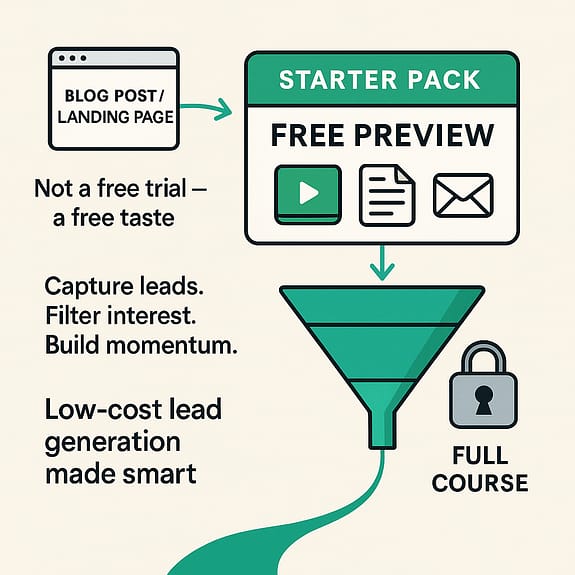
That’s it.
It wasn’t a “trial.” It was a taste. Tantalizing enough to leave the audience wanting more.
And, of course, my go-to tool was Thrive Apprentice to lock the rest of the course. That way, people could see the value, get excited, and immediately see the next step — without me chasing them.
This is classic low-cost lead generation. No paid ads. No funnel consultant. Just value + structure. It's also one of the smartest ways to promote an online course free — especially when you're building a simple, scalable digital product funnel.
Here’s what I recommend if you’re new to this:
Pick one powerful lesson or idea from your course — something they can implement today
Create a free version (video, PDF, or a quick mini-lesson in Apprentice)
Gate the full course using Thrive Apprentice's access restrictions.
Set up a short 3-email welcome sequence to build trust and explain why your full course is the next logical step
You don’t need to create a whole new funnel. Just repurpose what you already have — and use it strategically.
A freebie done right doesn’t just add value — it can quietly do the heavy lifting behind the scenes. It’s one of the simplest ways to build momentum, grow your audience, and sell online courses on WordPress — without spending a cent.
4. Turn One Testimonial into Ten Sales (Yes, Really)
Now I know that you know that I know that you know testimonials are important.
You’ve probably heard about them everywhere — landing pages, YouTube videos, maybe even that one overly intense marketing podcast. And I’m here to tell you: you really do need them, friend.
Especially when you’re doing online course promotion on a budget.
Because let’s be really real — you’re not out here buying Facebook ad slots during the Super Bowl. You need marketing that works hard and costs you nothing. That’s where social proof comes in.
🔎 Real talk: testimonials can boost conversions by 34%, and 92% of people read them before buying anything online. Including your course. (Invesp & Exploding Topics)
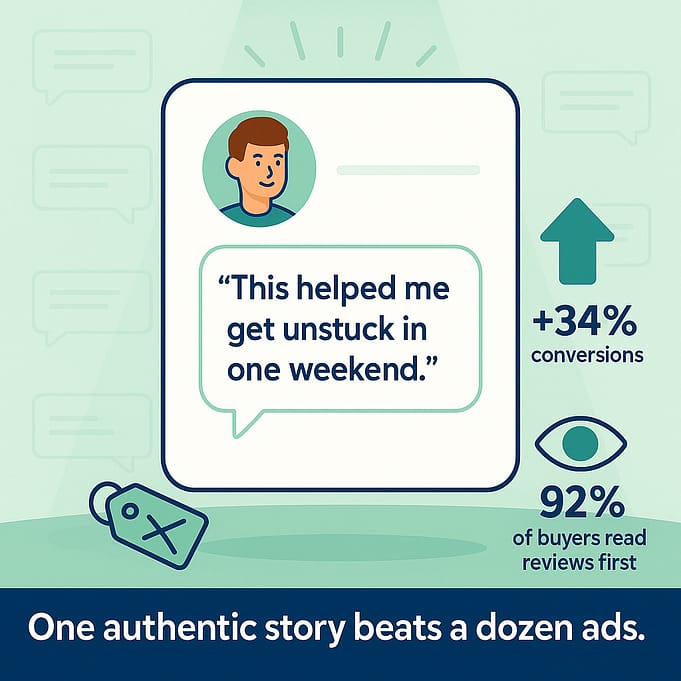
And no, you don’t need dozens of them. One specific, relatable story can be more powerful than a full page of vague praise.
This is the kind of student testimonial your course actually needs — clear, personal, and full of mini transformation moments.
Quick Storytime
When I worked on one of my fitness client’s first courses, we had to get creative. They didn’t have clients yet – just a good plan and a strong offer. So I rallied a few friends and we went through the program together.
It turned out to be a hit. We actually enjoyed the workouts, lost a few pounds in the process, and gave real, honest testimonials — which was perfect, because I was definitely not about to lie. One reply turned into a headline. One sentence turned into a conversion driver.
✅ If the idea of asking for testimonials still makes you want to crawl under your desk, here’s a simple way to ask without feeling awkward.
✅ And once you’ve got the gold, here’s how to collect and display testimonials on your site so they actually convert.
Want to do the same? Here’s how to get testimonials that sell:
After a lesson or module, ask: “What surprised you?” or “What clicked after trying this?” (Keep it casual. People open up more when you’re not holding a clipboard.)
Create a quick quiz feedback survey or use email automations to catch it while the experience is still fresh.
Don’t call it a “testimonial.” Just ask for their experience — and pull the good stuff.
And once they’ve had a great experience? That’s your moment. Because happy students are way more likely to share — they just need a little nudge and a reason to do it.
So instead of letting that post-course glow fade into the inbox abyss, give them something fun (and effortless) to act on.
You don’t need a full-blown affiliate program. Just offer a small, specific incentive:
A bonus lesson
A downloadable goodie
A cheeky “VIP shoutout” in your next email
Then say: “Share this link with a friend — when they sign up, you unlock your bonus.”
💡 You Can Keep It Simple (and Smart) with RewardsWP
- Use RewardsWP to create a built-in referral system on your WordPress site — no duct-taped tools, no spreadsheets.
- After someone signs up or buys, RewardsWP gives them a personal referral link (shared right from a slick widget on your site).
- When a friend joins through their link? Both of them get rewarded. You choose the perk — a bonus lesson, discount, freebie — RewardsWP handles the rest.
- Track it all from your dashboard (referrals, redemptions, activity), and use Thrive Apprentice to unlock exclusive content only for your MVP referrers.
No expensive software. No weird tech stack.
Just one clear path to sell online courses on WordPress with the help of people who already love your content.
5. Go Beyond Social Media — Show Up Where It Counts
If you’ve been juggling Reels, emails, student questions, and five platforms like it’s your job — pause. Breathe. This isn’t the way.
Social media is noisy, time-hungry, and frankly? Not always where your buyers hang out. Especially when you’re running lean.
So here’s your permission slip: You don’t need to go viral. You just need to show up in the right places.
When I stopped trying to “stay active” on Instagram and dropped a thoughtful comment in a Facebook group, it led to a DM… which led to an opt-in… which led to a sale. No dance trends required.
💡 Only 43% of consumers trust social media, but 81% trust advice from online communities or forums. (HubSpot & Exploding Topics)
This is one of those underrated, free course marketing tips no one tells you about — but it works.
Here’s where to focus your online course promotion energy instead:
Reddit & Quora – Find real questions about your topic and answer with value. Link to a blog post, not your cart.
Facebook or Slack groups – Be helpful, build trust, and share your course only when it makes sense.
Guest on small, relevant podcasts – Borrow someone else’s audience that’s already primed.
Email the list you have – Even 7 subscribers are better than 7,000 passive followers.
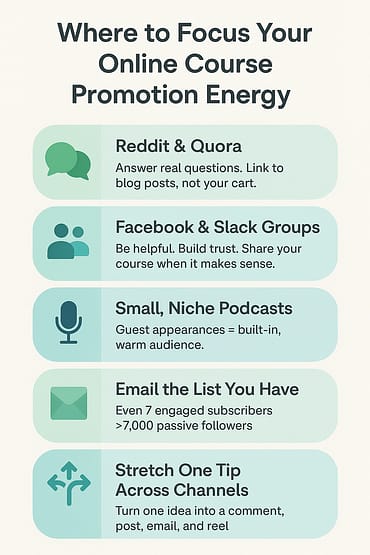
Take one good tip from your course and stretch it across a comment, post, email, and reel if you’re up for it.
This is what budget friendly course marketing actually looks like — focused, strategic, and totally doable.
6. Track What Works and Tweak What Doesn’t
If you’re not a numbers person, this part probably made you sigh… or roll your eyes. But stay with me, friend — this is important.
You don’t need to become a spreadsheet wizard or obsess over every stat. But if you’re not tracking anything, you’re likely spending time on stuff that isn’t actually moving the needle.
And when you’re doing budget friendly course marketing, time is money.
Here’s how to keep it simple and strategic:
Google Analytics + MonsterInsights – Don’t just install Analytics and forget about it. MonsterInsights makes it ridiculously easy to see key data — like your most visited pages, referral sources, and top-performing content — right inside your WordPress dashboard. 👉 Here’s our guide on how to set up Google Analytics on WordPress the smart way.
And if you’re using Thrive Apprentice for your courses? You’ve got bonus visibility baked in. Its course performance dashboard shows you how many students start, finish, and drop off — all from inside your WordPress course marketing setup. No extra tracking tools needed.
Thrive Optimize – A/B test your headlines, CTA buttons, or testimonials without the tech headache.
Watch your opt-ins + emails – This is where email marketing for online courses either shines or struggles. If your freebie flops or no one’s clicking email #3, it’s not personal — it’s just a chance to improve.
🧠 I once changed an email subject from “Let’s talk about your goals” to “What’s your course REALLY about?” and click-throughs nearly doubled. Same content. Just better framing.
You don’t need to track everything. Just enough to make smarter moves — and stop wasting time on stuff that isn’t working.
7. Bonus: 3 Creative Funnel Styles to Try on Any Budget
If you've made it this far, you’ve already got the foundations for a powerful digital product funnel — but let’s turn the volume up just a little. Because marketing doesn’t have to be boring. And you? You're allowed to have a little fun while selling your course.
These funnel ideas are playful, smart, and surprisingly easy to set up with the tools we’ve already talked about. No massive ad spend. No complicated tech stack. Just good strategy with a creative twist.
✨ Funnel Style 1: The Escape Room Funnel
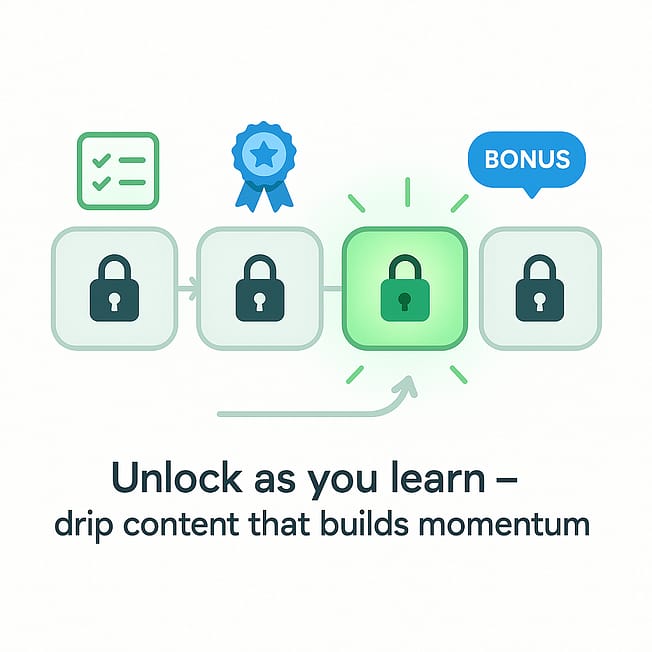
Let people “unlock” value one step at a time.
Use Thrive Apprentice to drip content in a way that feels like a challenge — lesson 2 only unlocks after lesson 1 is completed
Add micro-rewards: checklists, badges, even a surprise bonus module
Build anticipation so they want to keep going
This is a fun, low-pressure way to sell online courses on WordPress while keeping people genuinely engaged
🔥 Funnel Style 2: The Tiny Cult (of Curiosity)
Don’t panic — we mean this in the best way.

Name your community or learning framework e.g. “The 5% Club” or “The Anti-Burnout Blueprint”) — something that makes people feel like they’re part of something special
Use Thrive Architect to build a landing page that introduces your movement and makes people want in
Gate exclusive content behind an email opt-in to start segmenting your most curious, committed fans
People want to belong to something. So give them something to belong to — and let your course become the next logical step in your WordPress course marketing journey.
🎯 Funnel Style 3: The Choose-Your-Own-Adventure Funnel
Let your leads tell you what they want before you pitch anything.
Use Thrive Quiz Builder to ask a few fun, strategic questions
Send them to a tailored opt-in gift based on their answers
Build a segmented email sequence that speaks directly to their goals
This is how to market an online course without guessing. You’re giving people exactly what they need — and making it fun in the process.
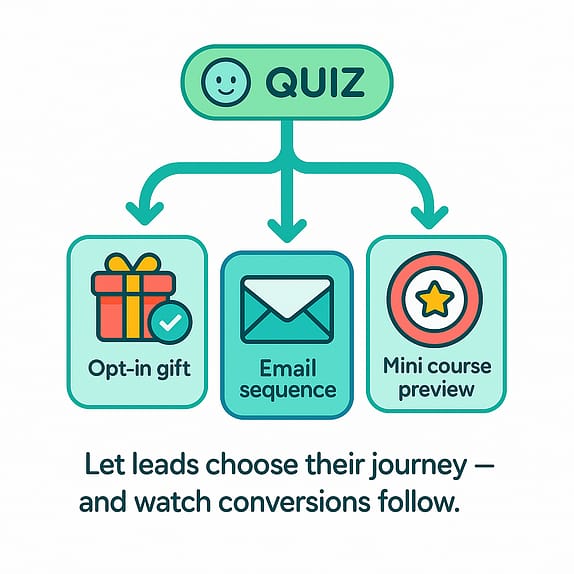
Each of these funnels can start small — like, weekend-project small. And you don’t need a big audience to see them work. You just need the right mix of curiosity, clarity, and conversion-focused design.
Which, lucky for you, is exactly what Thrive tools were made for.
💬 FAQs: Budget Friendly Course Marketing (Real Talk Edition)
1. Can I actually market my course without spending money on ads?
Short answer? Yes. Longer answer? You should — especially at the start.
Organic traffic (SEO), lead magnets, helpful blog content, and showing up in the right communities can get you way further than you think. This is one of the most reliable ways to promote an online course free, and it works.
I didn’t run ads until way later, and honestly? I wish I’d ignored them even longer.
You don’t need Meta’s blessing to make sales. You need strategy, consistency, and content that actually speaks to your people.
2. What if I don’t have an audience yet?
Ah, the classic chicken-and-egg problem. But don’t stress — you can still launch.
Start by solving a real problem. Write one helpful blog post (hello, content marketing for courses). Show up in one niche group. Offer one small freebie.
This is low-cost lead generation at its finest. It’s less about going viral and more about being useful to five people who actually care.
Build tiny, build well — it adds up fast.
3. What’s the best free or low-cost way to get leads for my course?
Honestly? A simple opt-in page and a good lead magnet. That’s it.
Offer a checklist, template, mini-lesson — whatever gives someone a small win fast. Build that in Thrive Apprentice or with Thrive Leads, and you’ve got a lean, high-converting funnel with zero ad spend and zero tech drama.
I’ve seen people build entire six-figure launches off a Google Doc and a decent email sequence. So… yeah. Don’t overcomplicate it.
4. How long does it take to see results from these strategies?
If you’re showing up consistently and being strategic (not just busy), most people see traction in 30–60 days.
Will you retire on your course money by then? No. But will you start seeing email sign-ups, interest, and the occasional Stripe notification that makes you happy dance? Very likely.
Keep it lean, stay in the game, and keep testing what works.
5. Do I need Thrive Suite to do this, or can I use free tools?
You can totally use free tools — but here’s the thing: free usually comes with friction. I used to waste hours trying to connect six plugins just to get a landing page and a form working properly. When I switched to Thrive Suite, everything just… clicked.
So no, it’s not required. But if you’re on WordPress and tired of tech headaches, it’s one of the smartest budget-friendly investments I made.
Conclusion: Budget Friendly Course Marketing That Actually Works
See?
You didn’t need a massive audience. You didn’t need to be everywhere. And you definitely didn’t need to drop a month’s rent on ads to start making real progress.
What you needed was clarity. A plan. Relief from the chaos. And hopefully? That’s exactly what this guide gave you.
Because budget friendly course marketing isn’t about hustling harder — it’s about making smarter moves with what you’ve got:
A site that’s built to convert (not just sit there looking cute)
Content that keeps working even when you log off
Tools that save you time, not waste it
And a funnel that feels like it finally makes sense
This is how real course creators grow — the ones doing it solo, teaching what they love, and figuring it out one smart step at a time.
So take what resonated. Try one tactic this week. You don’t need to do it all. You just need to start.
And when you’re ready to simplify your setup and stop duct-taping your marketing together? 👉 Thrive Suite gives you the tools to build a course funnel that actually works — without draining your wallet or your will to live.
You’ve got this. And I’m right here cheering you on.


